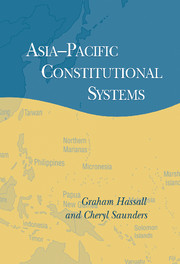Book contents
- Frontmatter
- Contents
- Acknowledgements
- Map: The Asia-Pacific Region
- Introduction
- Part I Modernity and Nation-States at the Dawn of the Global Era
- 1 Traditional states and colonisation
- 2 The modern constitution
- 3 Writing the constitution
- Part II The Constitution of Modernity
- Part III Democracy and the Rule of Law
- Conclusion: Postmodernity and constitutionalism
- Appendix: Chronology of constitutional events in the Asia Pacific
- Bibliography
- Index
1 - Traditional states and colonisation
Published online by Cambridge University Press: 09 October 2009
- Frontmatter
- Contents
- Acknowledgements
- Map: The Asia-Pacific Region
- Introduction
- Part I Modernity and Nation-States at the Dawn of the Global Era
- 1 Traditional states and colonisation
- 2 The modern constitution
- 3 Writing the constitution
- Part II The Constitution of Modernity
- Part III Democracy and the Rule of Law
- Conclusion: Postmodernity and constitutionalism
- Appendix: Chronology of constitutional events in the Asia Pacific
- Bibliography
- Index
Summary
The constitutions in operation in the Asia Pacific in the second half of the twentieth century, often described as statements of 'national independence', should more properly be regarded as being among the final artefacts of the colonial era. Their imposition on peoples and states was everywhere contested, albeit at different levels of intensity and in ways sometimes explicit, but also in deep-rooted, almost subterranean forms that continue to survive and manifest themselves in the conflict-laden public lives of modern times. But before telling these stories, we must review an earlier period, for the peoples of Southeast Asia and the Pacific Islands have constitutional histories considerably more extensive than those of current memory.
Knowledge of prior constitutional arrangements assists an understanding of the present in all parts of the world: in Asia and the Pacific, it is essential. Before regular European contact, political communities throughout Asia conducted their affairs according to sophisticated legal codes, as did the chiefly regimes of Polynesia and other parts of the Pacific. Relations between ruling elites and peasantry were based on patron–client relationships akin to those that existed under European feudalism. Obligations had to be observed on both sides to ensure maintenance of the political system. As a generalisation, in the case of most former colonies and as ironic as it may appear to be, independence constitutions were greatly influenced by the legal institutions and practices of those responsible for their bondage.
- Type
- Chapter
- Information
- Asia-Pacific Constitutional Systems , pp. 13 - 28Publisher: Cambridge University PressPrint publication year: 2002

